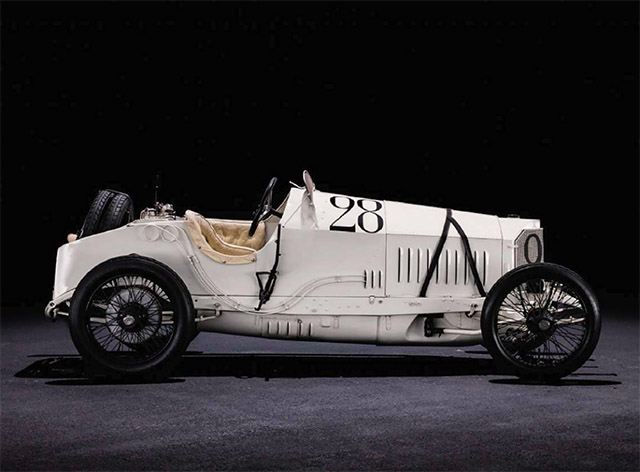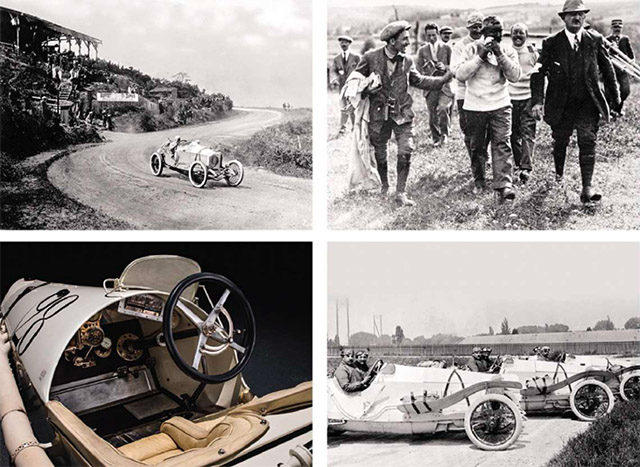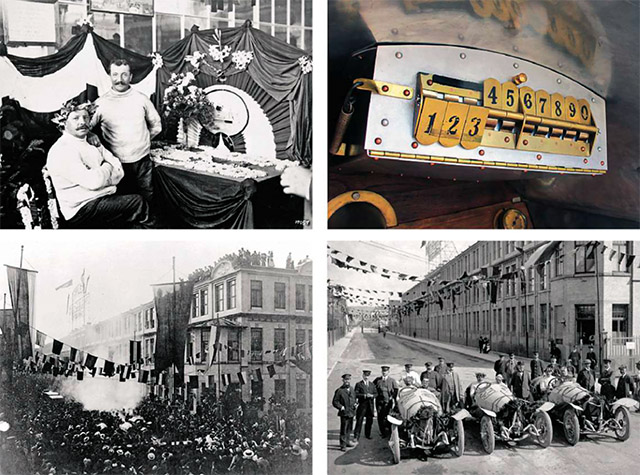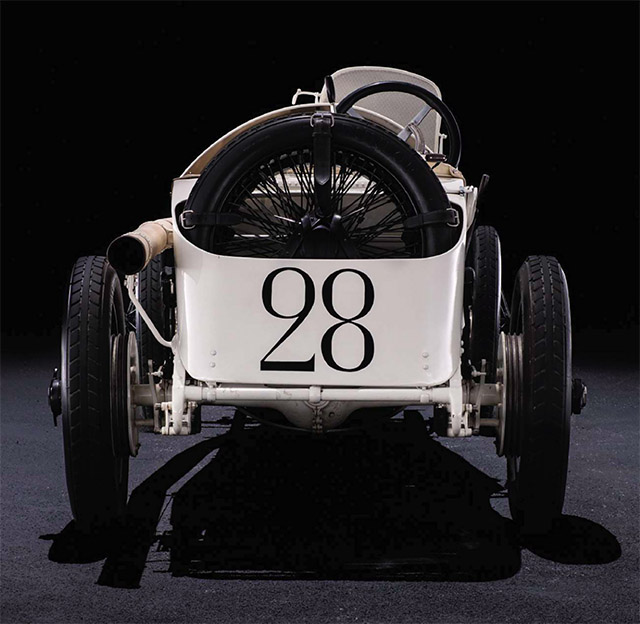
Anatomy, of a masterpiece. The epic 1914 French Grand Prix was the last race before the Great War. Mick Walsh investigates Christian Lautenschlager’s winning Mercedes – photography Mercedes-Benz classic.
If you imagine that the Formula One season was focused on a single race, then you’d begin to appreciate the intense excitement for the 1914 French Grand Prix. Little wonder that the 4 July event drew more than 300,000 spectators to the Lyon region to witness the spectacle of the greatest drivers in the fastest racing cars on earth. The event featured 14 factory teams, with 37 cars from six countries competing in the standalone event that demanded fresh designs with newly imposed regulations limiting engine capacity to 4.5 litres and weight to 1100kg.
The sensation of the race was the five-car Mercedes equipped that the Stuttgart factory had spared nothing to build, prepare and test for the prestigious 20-lap, 467-mile challenge on public roads. The contest developed into a titanic battle between the dashing Gallic favourite Georges Boillot in a blue dual-overhead-cam Peugeot and the wedged-nosed white chargers. Right until the last lap, the German team pressurised Boillot, who’d won for the past two years, until the Peugeot cried enough with a seized engine on the final run towards La Madeleine.

Clockwise, from top left Lautenschlager’s car leaves a smokescreen: Pilette, the only non-German team driver; aero-engine design clear in Mercedes ‘four; with tape to stop fractures; well-rehearsed pitstop for Wagner, second.
Christian Lautenschlager’s leading Mercedes roared past, the Swabian ace and his mechanic Hans Rieger glimpsing their popular rivals for the first time in the seven-hour enduro. French national pride was shattered by a German 1-2-3, and the stunned crowd quickly left the barriers and stands after the finish. Even the band declined to play the victors’ national anthem at this extraordinary event. Just weeks later, the horror of war engulfed France.
Of the three Mercedes team cars that actually raced at Lyon, only the winner survives and in April it returned to the scene of its triumph to rerun the triangular, high-speed 23-mile course 100 years on. At the wheel of the famous number 28 was septuagenarian George Wingard, a passionate American enthusiast who has owned Lautenschlager’s victorious machine for 30 years. Few know the 1914 design better than the Oregon-based collector.


Clockwise, from above: aerodynamic lines protected driver and mechanic: Lautenschlager at ‘Death Corner’: winner, with bloodied hand, and mechanic Rieger walk to the victory presentation: only driver got a stoneguard.
“It’s a dream to drive,” enthuses Wingard. “The 1908 chain-drive GP car is a horse, whereas this is like a ballerina in comparison. The steering is beautiful and the handling is very balanced. It’s also comfortable, which was important for a marathon race. The brakes are the main handicap on performance because you really have to think about the stopping distance. The Mercedes couldn’t match the Peugeot into the corners, but it was quicker out of them.”
When Wingard acquired the Mercedes, he was hugely disappointed by the initial driving experience: “It was difficult to start, it had the acceleration of a slug and the gearbox was impossible to work. I thought I’d made a big mistake, because I’d always been advised that ‘you only need to drive a car to know it’s truly great’. This one turned out to be a mechanical dog, with the wrong pistons, while the missing pilot shaft in the flywheel made clean gearchanges impossible. But once we’d rebuilt it, including replacing the front axle, fitting new shock absorbers and refabricating the body using original factor}’ blueprints, the car was transformed. It was the exact opposite of how it had been before – quick, smooth shifting and as stable as a country rock.” The superb engineering of the 1914 Mercedes hugely impressed Wingard: “The steering is a work of art, with the worm-and-nut design using the entire box to bear the torque of the turning thrust. The four-speed, all-ball-bearing trans-mission shifts up and down with little effort. The spring-cam dampers on all four corners restrict wheel bounce to a minimum. It all adds up to one of the most memorable drives of all time.”

Clockwise, from top left Lautenschlager (with laurels) and mechanic Rieger at reception: clever brass cockpit lap counter; photo-call on return to the Mercedes factory; amazing welcome back home in Stuttgart for the victors
That opinion is backed up by former GP ace and sports-car legend Jochen Mass, who’s driven a wealth of historic Mercedes racers. “I love it. The gearbox is fantastic once the thick oil is warm, and the engine really likes to rev,” reports Mass after demonstrating the factor)’ Museum jewel around the Lyon circuit. “They used to rev to 3500rpm – we’re limited to 2600, but there’s lots of torque. It feels like a true racing car and is light years ahead of the 1908 Benz. Once up to speed, the steering is light. A child could steer it. It’s much nicer to drive than an SSK, which is brutal in comparison. After testing the 1914 car, it’s easier to appreciate why Mercedes won. They had the best technology matched to the best drivers and best planning.”
As well as rebuilding this important car to authentic specification, and demonstrating it at events all over the world, Wingard has just written a superb history of the 1914 GP: “Every time I drive the car, I’m humbled by the efforts of Lautenschlager and his team. To race for seven hours must have taken super-human stamina and concentration. The winning car suffered from extra vibration at maximum torque (see Top ten opposite) and, if you look carefully at historic photographs, you can sec Lautenschlagcr’s hand wrapped in a blood-stained handkerchief.”
The former Oregon senator has been restoring old cars since rebuilding a 1915 Buick when he was a teenager, and has subsequently owned some of the finest early racers. That mechanical insight and driving experience has given him a unique perspective on the 1914 design: “The attention to every detail was key to its success. The ignition system was made failsafe by using two magnetos and, with four plugs per cylinder, fouling was almost out of the question. Even the cooling capacity was double the amount needed.” Aviation influence is clear in both the engine and body design, notes Wingard: “With the vee-shaped radiator and body rising up around the drivers, its frontal area was far smaller than its rivals. Wooden vee-shaped fairings were fitted to the front axle, and the aluminium belly pan ran the full length of the chassis to further reduce drag. With a 4.5-litre engine limit, the designers really thought about maximising performance.
“Its other impressive details include the twin fuel lines in case one clogged up; there’s a fuel- pressure gauge on the rear tank that only the mechanic can easily read; and the lap counter with brass numbered flaps in the cockpit. In a long race, it was easy to forget which lap you were on. On the floor is a little round pedal that the mechanic has to press every five minutes to lubricate the camshafts, valvegear and cylinder walls. The cars had a total-loss oil system – the pistons also had no oil rings-which is why they often smoked at high speed. For once, lubricant running over the chassis was a good sign.”
Eddie Berrisford is also intimately familiar with the 1914 design after a five-year rebuild of the Collier Collection’s car, which was used on recces but did not race: “The biggest surprise was that Mercedes didn’t fit front brakes, but there was a theory at the time that having only rear brakes was safer. Even the SSK has a 70% bias to the back. It’s the weakest part of the design.”
The four-pot engine massively impressed Berrisford, however. Each cylinder is individually forged with welded-on sheet-metal water jackets. A single overhead camshaft is driven by the crank through spur gears and a vertical shaft at the rear of the engine. “The four-valve heads breathe well, with good cross-flow,” he explains. “Bentley copied this straight away. You can see it in his designs and the aero engines of Packard and Liberty. The bottom end, with five main plain bearings, is really strong. There’s no oil pressure because lubricant is circulated by a beautiful pump. The factory experimented with alloy pistons and drivers were given the choice for the race. Most went for cast iron. The weakest point is the thin H-section conrod. The carburettor is a racing type with barrel throttle, while the manifold was made from flat copper and beaten into shape – a difficult part to make.”
Berrisford agrees with Wingard about the team’s preparation: “They used a lot of tape around the joints, which would suffer constant vibrations on dirt roads. Baffles were made for the front and around the magnetos to stop water seeping in. The cars were also spray-painted, probably a motor sport first, but that was simply to save time because a brush job would take eight weeks. The chassis is well braced and die springs are exquisitely made with Styrian steel.”
Berrisford also found that the corner load was perfect at 250kg each: “I reckon that the cars must have been overweight because you can see that features were changed from the prototype, and drilled parts such as the gearlever appeared.”
The survival of Lautenschlager’s winning car is one of the most amazing ‘wolf in sheep’s clothing’ stories in automotive history.
English enthusiast Philip Mann made the discovery of the century in 1961 when he pulled a tatty Mercedes with a Berliet tourer body out of a private garage in Essex where it had been stored since 1932. Eighteen years earlier-after the landmark victory — the team had wasted little time in packing up and driving the cars, with mudguards rigged up over the front wheels, back to Stuttgart By all accounts, the reception was at the local dance hall. Three weeks after the event, the winner, still sporting the number 28 painted on its bodywork, was shipped to London. Just days after Lautcnschlager’s battle-scarred beauty – bedecked in laurel wreaths – went on display in the Mercedes showroom, war was declared, and the famous racer was stuck in the UK.

As the grim conflict developed in September, with the battle of Marne and the sinking of Royal Navy cruisers in the North Sea, two young volunteers – WO Bentley and Leonard Geach – advised the Admiralty about the German GP car. The white two-seater was quickly commandeered from the London depot and sent to Rolls-Royce at Derby where it was closely inspected, but with strict instructions that no patents were to be infringed and only the power- plant should be studied. Colourful stories that Bentley drove the Mercedes to Derby – or that Roy Feddon towed it the 200 miles – arc not true. Story has it that the chassis was wrapped in brown paper so that it couldn’t be copied, but the design influence is obvious in Rolls-Royce’s engines, which later powered aerial combat against enemy planes with Mercedes motors.
After the war, die 1914 French GP winner was acquired by Count Zborowski and was still a front-runner in the early ’20s at Brooklands, where it regularly posted 100mph-plus laps. As the car became uncompetitive, it was converted into a tourer in 1923 by CG Brocklebank, and nine years later went into storage where it remained for the following three decades until Mann and Stanley Sears secured it for £800.
By studying old Brooklands photos, Mann confirmed the car’s identity and, after a thorough restoration, it became a feature of Vintage Sports-Car Club events until Wingard acquired it from London dealer Charles Howard in 1984.
There was some confusion over which racer had the winning chassis because the factory sent out three cars for sales promotion to dealerships in London, Paris and Brussels-all numbered 28. Fortunately, the bodies differed slightly in detail and Mann noted that the Lautenschlager Mercedes uniquely had 10 louvres on the driver’s bonnet side, which matched the Brooklands images. Further evidence came to light when Wingard found 15364 stamped on various parts, tallying with the factory’ records.
The brilliance of the 1914 design was confirmed by its competitive performance in later events. American hero Ralph Dc Palma drove a team car to victory in the 1915 Indianapolis 500, despite running the final lap son three cylinders after a conrod broke. After they had been modified by the factor)-, the cars also went on to win the 1922 Taiga Florio and regularly set fastest times at major hillclimbs across Europe. What better testament to the excellence of Paul Daimler’s engineering team?
George Wingard’s history of the 1914 French GP is priced at $100, with profits going to prostate cancer research: GP Mercedes Publishing, 2323 Fairmont Boulevard, Eugene, Oregon 9703 USA
Top ten facts about the 1914 GP Mercedes and the team
1 When Lautenschlager’s winning car was sent to London for display in July 1914, the carburettor and inlet manifold were removed to avoid the temptation of joy-riding while it was on loan.
2 Christian Lauterschlager was 37 when he won the 1914 French Grand Prix, his second great victory on Gallic soil after his marathon 1908 drive at Dieppe. After WW1, though, his competitive edge was no match for the Belle Epoque years with a 10th of the 1922 Targa Florio his best placing. He continued to work at Mercedes in Stuttgart and died in January 1954.
3 As soon as the course was announced, all manner of exotic touring cars appeared around Lyon to test the dusty, undulating route. Mercedes arrived (having driven from Stuttgart) three months before the event and, with military precision, practised for a fortnight. Meticulous notes were made of the course by Alfred Vischer including elevation graphs. Early in April, the roads were closed to racing cars.
4 After a very wet scrutineering session, race day was hot and sunny. Cars were flagged off in pairs at 30-second intervals, and it was Max Sailer’s Mercedes that set the pace. An inexperienced racer, Sailer was nominated to be the hare to Boillot’s Peugeot, but the leading Mercedes broke a conrod through the Gier section on the sixth lap. Sailer’s only consolation was that he claimed the fastest lap, at 20 mins 6 secs (69.8mph).
5 Belgian Mercedes dealer Theodore Pilette lobbied hard for the 1914 GP designs to feature chain drive, but designer Paul Daimler opted for shaft over chain to save weight.
Thorough planning: Alfred Vischer’s course recce notes
6 The four-wheel-braked Peugeots could go deeper into corners at Lyon, but the Mercedes could out-accelerate them on the exits. The extra braking also resulted in greater tyre wear and more pitstops to change wheels.
7 The well-drilled Mercedes pit used red cans for petrol, yellow ones for oil and white tins for water. The 1914 GP car’s oil tank carried 25 litres and fuel consumption was 10-12mpg.
8 The 4.5-litre, four-cylinder Mercedes engine featured a single overhead camshaft and 16 valves. At a heady 3000rpm, it produced 105bhp with maximum torque 209lb ft at 2000rpm.
9 A fourth 1914 GP team car (the runner-up) survived until WW2 but, along with a W25 and the advanced mid-engined Benz Trophen-Wagen, it was destroyed during Allied bombing.
10 “The sweetest music that I have ever heard is the song of this engine, but at 3600rpm the vibration is pure hell,” reminisced Lautenschlager. During testing by Mercedes’ aero-engine staff, the GP ‘four’ was run to destruction at over 5000rpm.





